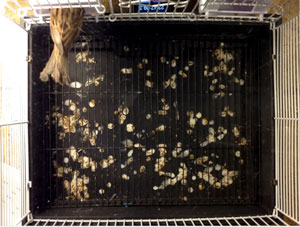How much waste can a 1-oz. house sparrow (Passer domesticus) produce in 24 hours? A week? A month? A year? Bird Barrier America wanted to know, and the answer was surprising.
“We found that an adult house sparrow drops about 200 waste deposits every 24 hours,” reports Cameron Riddell, president of the Carson, Calif.-based manufacturer.
Riddell notes that the team got this information by catching a sparrow, putting it in a cage with food and water, placing a clean black panel of cardboard on the floor of the cage, and running video for 24 hours. Afterward, the bird was released back into the wild. Watch the time-lapse video here.
Two hundred droppings a day equates to 1,400 droppings per week, 5,600 per month and 71,280 droppings per year per single sparrow.
“If this productive little fellow lives inside a retail environment, that translates into a lot of deposits on shelving inventory, shopping carts, lights, and even open produce,” Riddell points out. “And what if there are four or five live birds inside a store, as is often the case? The annual output can top 350,000 deposits on sensitive areas.
“So the next time you see a sparrow flying innocently overhead, realize that you may be witnessing one very productive little fellow placing unhealthy deposits in hundreds of supposedly sanitary sites throughout a retail environment, and maybe even directly onto food that someone may serve to their family that night,” he adds.
Of course, there are things pest management professionals (PMPs) can do to provide relief to their customers, Riddell says:
- Conduct a thorough survey to find out whether birds are coming and going from the store, or if this is a totally resident flock that has found everything it needs to survive inside. Identify what they are eating, drinking, and where their nest(s) is located.
- Catch and remove the birds using indoor bird traps.
- Inspect the exterior of the facility to determine where birds are entering and make recommendations and apply prevention products to popular perching areas and favorite roosting trees. These measures will help property owners reduce the chance that birds will re-enter through high-traffic entryways, skylights and and dock and loading doors.

Leave A Comment